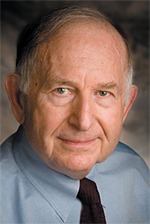Lighting and Visualization

The purpose of this month's offering is to suggest a very simple and useful tool to assist in the visualization of how a scene will translate into a video image. Lighting people deal with this situation constantly. Not only do we want to place the elements of our scene in a pleasing composition, we also want to control the visibility of each element. This visibility depends upon the overall transfer characteristic of the system that translates the live scene into the viewed image.
CONTRAST
In the most common situation, the primary subject is a person's face. What should be its relationship to the other elements of our picture? Yes, size and color are important, but let's concentrate only on the separation between picture components due to differences in brightness. A simple method to ascertain and compare these brightness differences is to remove the color; in other words, reduce the chroma to zero. We now have a monochrome image so the eye can easily discern the difference in brightness between our primary subject and the rest of the picture's components. The color TV system is composed of a black-and-white image to which the color information is separately applied. This is also the basis of all color classification systems.
REFLECTANCE
We define each of the grays from white to black in terms of their reflectance. Reflectance is defined as the percentage of light that is returned to a viewer from a lighted matte surface. The brightness of a surface with a high value of reflectance is greater than a surface with lower reflectance under the same illumination. The reflectance of the perfect, but unrealizable, white surface is 100 percent. It returns all the light that it receives. Conversely, the perfect black would have a reflectance of zero percent and return no light.
PREDICTING THE FUTURE
If we know the reflectance of our subjects, we can utilize this information to predict the relative signal levels that we can expect when we put these subjects on camera. The following describes a simple method to determine reflectance.
First, we need a set of grays whose reflectance has been calibrated. Many standards are available but can be quite expensive. I chose to use a simple, very inexpensive "Value Finder" available from The Color Wheel Company and at many art supply stores. This will do for our purposes. The numbers (91, 73, 58, etc.) are my estimates of the reflectance of each of the ten gray chips and should be copied onto the Value Finder card.
Place the surface to be tested behind the slots on the card which seem to be close to the reflectance of the sample. The item under test in Fig. 1 is a sample chip of "dove grey" laminate. Light the Value Finder card and the test sample evenly without any specular reflections. Take a photo with your digital camera (flash off, of course). Place the picture file into the photo editor in your computer (as Photoshop, Photo Editor, etc.) and remove the color. The photo shows the result of this procedure and the appearance of the monochrome image.

Fig. 1: A sample chip of "dove grey" laminate from a Value Finder card.COMMON VALUES
Here are some of the reflectance values that you should know. The chip labeled "58," close enough to use as 60 percent reflectance, is what has been traditionally known as "TV white," the theoretical limit of the TV broadcast system. Actually, with today's cameras, this is no longer true. The transfer function at the white end has been altered in most cameras to extend the white limit to at least the next chip of 73 percent (to provide increased dynamic range). The chip labeled 30 percent has always been noted as the reflectance of an average Caucasian face. The 19 percent reflectance chip is about the 18 percent reflectance that film exposure and light meters chose as mid-range of the entire range of brightness of an "average" scene!
LET'S SQUINT
To determine the reflectance of our laminate sample, squint your eyes a little bit and compare the brightness of the sample and card. The sample is definitely lighter than 30 percent and darker than 58 percent. The reflectance of the sample is very close to the 44 percent gray on the Value Finder. If we apply the same test to the background paper, we judge that its reflectance appears greater than 19 percent and less than 25 percent. We may now make the conclusion that if we are shooting an average person standing directly in front of a wall in the same light, our laminate sample would be brighter than the face. In most cases this would be undesirable. However, if the photo's background were the background wall's value, this would not be the case. The wall would provide the desired separation as it will be darker than the face.
I hope that you can adapt this very simple tool to your working method. I find that it has been very helpful in providing reassurance.
Bill Klages would like to extend an invitation to all the lighting people out there to give him your thoughts at billklages@roadrunner.com.
The professional video industry's #1 source for news, trends and product and tech information. Sign up below.
